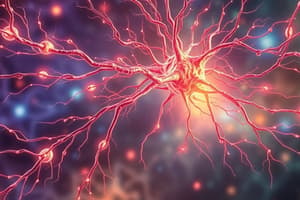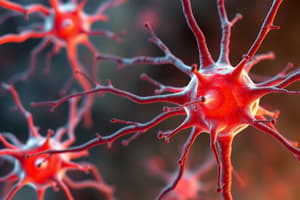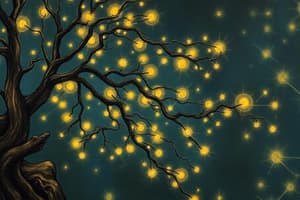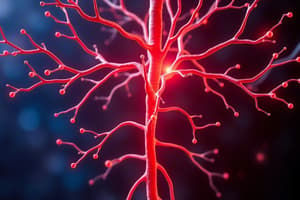Podcast
Questions and Answers
What neurotransmitter is released by postganglionic neurons in the parasympathetic nervous system?
What neurotransmitter is released by postganglionic neurons in the parasympathetic nervous system?
- Norepinephrine
- Epinephrine
- Dopamine
- Acetylcholine (correct)
Which term best describes neurons that release acetylcholine?
Which term best describes neurons that release acetylcholine?
- GABAergic
- Noradrenergic
- Adrenergic
- Cholinergic (correct)
What is the primary neurotransmitter released by most postganglionic neurons in the sympathetic nervous system?
What is the primary neurotransmitter released by most postganglionic neurons in the sympathetic nervous system?
- Serotonin
- Norepinephrine (correct)
- Epinephrine
- Acetylcholine
If a neuron releases norepinephrine (NE), what term would be used to classify the neuron?
If a neuron releases norepinephrine (NE), what term would be used to classify the neuron?
What is the neurotransmitter released by preganglionic neurons in both the sympathetic and parasympathetic nervous systems?
What is the neurotransmitter released by preganglionic neurons in both the sympathetic and parasympathetic nervous systems?
How do acetylcholine (ACh) and norepinephrine (NE) typically affect target organs in the autonomic nervous system?
How do acetylcholine (ACh) and norepinephrine (NE) typically affect target organs in the autonomic nervous system?
At the neuroeffector junction, what neurotransmitter is released by postganglionic neurons of the parasympathetic pathway?
At the neuroeffector junction, what neurotransmitter is released by postganglionic neurons of the parasympathetic pathway?
Which neurotransmitter is NOT primarily associated with the autonomic nervous system?
Which neurotransmitter is NOT primarily associated with the autonomic nervous system?
What is the fundamental concept of the 'Neuron Doctrine'?
What is the fundamental concept of the 'Neuron Doctrine'?
Which of the following best describes the Central Nervous System (CNS)?
Which of the following best describes the Central Nervous System (CNS)?
What is the primary role of motor nerves within the nervous system?
What is the primary role of motor nerves within the nervous system?
What is the main function of sensory nerves?
What is the main function of sensory nerves?
According to the content, what are the two main divisions of the nervous system?
According to the content, what are the two main divisions of the nervous system?
Which of the following is considered the minimal functional unit of the nervous system?
Which of the following is considered the minimal functional unit of the nervous system?
What is the primary function of a neuron?
What is the primary function of a neuron?
Based on the content, what is a major reason for the close association between physiology and anatomy in the nervous system?
Based on the content, what is a major reason for the close association between physiology and anatomy in the nervous system?
According to the provided diagram, what are the two main divisions of the nervous system?
According to the provided diagram, what are the two main divisions of the nervous system?
Which division of the nervous system includes the brain and spinal cord?
Which division of the nervous system includes the brain and spinal cord?
The Autonomic Nervous System is further divided into which two systems?
The Autonomic Nervous System is further divided into which two systems?
What does the term 'chromothesia' refer to in the context of the text?
What does the term 'chromothesia' refer to in the context of the text?
What is the specific type of synesthesia where letters or numbers are perceived as being inherently colored?
What is the specific type of synesthesia where letters or numbers are perceived as being inherently colored?
A musician experiencing different tastes in response to musical tones would be an example of:
A musician experiencing different tastes in response to musical tones would be an example of:
Which of the following is NOT directly mentioned as being included in the 'Efferent' division?
Which of the following is NOT directly mentioned as being included in the 'Efferent' division?
Based on the text provided, what processes are associated with the peripheral nervous system?
Based on the text provided, what processes are associated with the peripheral nervous system?
What is one primary function of the blood-brain barrier?
What is one primary function of the blood-brain barrier?
What is the significance of rapid treatment with anti-rabies antibodies before symptom onset?
What is the significance of rapid treatment with anti-rabies antibodies before symptom onset?
Which of these components is described as influencing the structure and function of the blood-brain barrier?
Which of these components is described as influencing the structure and function of the blood-brain barrier?
Based on the content, what is a direct effect of the rabies virus on the central nervous system?
Based on the content, what is a direct effect of the rabies virus on the central nervous system?
What type of infection does the content primarily discuss in relation to the blood-brain barrier?
What type of infection does the content primarily discuss in relation to the blood-brain barrier?
Why is the blood-brain barrier a consideration in the treatment of neurological disorders?
Why is the blood-brain barrier a consideration in the treatment of neurological disorders?
Which of the following diseases is mentioned in the text as associated with the blood-brain barrier?
Which of the following diseases is mentioned in the text as associated with the blood-brain barrier?
What can happen if the rabies virus is left untreated until after the onset of symptoms?
What can happen if the rabies virus is left untreated until after the onset of symptoms?
What is the primary function of ion channels in the nervous system?
What is the primary function of ion channels in the nervous system?
How do voltage-gated ion channels contribute to electrical activity in axons?
How do voltage-gated ion channels contribute to electrical activity in axons?
What is the initial state of voltage-gated ion channels in axons?
What is the initial state of voltage-gated ion channels in axons?
What type of signal transmission occurs in axons?
What type of signal transmission occurs in axons?
What is the main function of action potentials?
What is the main function of action potentials?
What causes a change in membrane potential in axons?
What causes a change in membrane potential in axons?
Where are sodium and potassium ions initially located at the start of an action potential?
Where are sodium and potassium ions initially located at the start of an action potential?
Which specific ion channels are primarily responsible for electrical activity in axons?
Which specific ion channels are primarily responsible for electrical activity in axons?
What primarily stimulates the opening of voltage-gated ion channels in the axon membrane?
What primarily stimulates the opening of voltage-gated ion channels in the axon membrane?
Why are the ion channels in the axon membrane described as voltage-gated?
Why are the ion channels in the axon membrane described as voltage-gated?
What mechanism prevents the membrane potential from becoming more positive than approximately 30 mV during an action potential?
What mechanism prevents the membrane potential from becoming more positive than approximately 30 mV during an action potential?
What does the 'all-or-none' principle of action potentials refer to?
What does the 'all-or-none' principle of action potentials refer to?
Which of the following best describes how action potentials are propagated?
Which of the following best describes how action potentials are propagated?
What is the typical order of events that leads to action potential generation?
What is the typical order of events that leads to action potential generation?
Which statement correctly describes the function of voltage-gated channels during an action potential?
Which statement correctly describes the function of voltage-gated channels during an action potential?
If a neuron receives a stimulus that causes only a small depolarization, what will happen?
If a neuron receives a stimulus that causes only a small depolarization, what will happen?
Flashcards
Central Nervous System (CNS)
Central Nervous System (CNS)
The brain and spinal cord, responsible for processing information and controlling bodily functions.
Peripheral Nervous System (PNS)
Peripheral Nervous System (PNS)
The network of nerves and ganglia that connect the CNS to the rest of the body.
Neuron
Neuron
The smallest functional unit of the nervous system, responsible for transmitting information.
Neuron Doctrine
Neuron Doctrine
Signup and view all the flashcards
Neurophysiology
Neurophysiology
Signup and view all the flashcards
Neuroanatomy
Neuroanatomy
Signup and view all the flashcards
Motor Nerves
Motor Nerves
Signup and view all the flashcards
Sensory Nerves
Sensory Nerves
Signup and view all the flashcards
What is the blood-brain barrier?
What is the blood-brain barrier?
Signup and view all the flashcards
What role do astrocytes play in the blood-brain barrier?
What role do astrocytes play in the blood-brain barrier?
Signup and view all the flashcards
How does the blood-brain barrier make treating neurological disorders difficult?
How does the blood-brain barrier make treating neurological disorders difficult?
Signup and view all the flashcards
What is rabies?
What is rabies?
Signup and view all the flashcards
What is the treatment for rabies?
What is the treatment for rabies?
Signup and view all the flashcards
How does the blood-brain barrier affect rabies treatment?
How does the blood-brain barrier affect rabies treatment?
Signup and view all the flashcards
How does nitric oxide (NO) affect the blood-brain barrier?
How does nitric oxide (NO) affect the blood-brain barrier?
Signup and view all the flashcards
Why is it hard for drugs to reach the brain?
Why is it hard for drugs to reach the brain?
Signup and view all the flashcards
Autonomic Nerve Classification
Autonomic Nerve Classification
Signup and view all the flashcards
Cholinergic Neuron
Cholinergic Neuron
Signup and view all the flashcards
Adrenergic Neuron
Adrenergic Neuron
Signup and view all the flashcards
Parasympathetic Outflow
Parasympathetic Outflow
Signup and view all the flashcards
Sympathetic Outflow
Sympathetic Outflow
Signup and view all the flashcards
Neuroeffector Junction
Neuroeffector Junction
Signup and view all the flashcards
Neurotransmitter Receptor Specificity
Neurotransmitter Receptor Specificity
Signup and view all the flashcards
Autonomic Nervous System
Autonomic Nervous System
Signup and view all the flashcards
What is the CNS?
What is the CNS?
Signup and view all the flashcards
What is the PNS?
What is the PNS?
Signup and view all the flashcards
What do afferent nerves do?
What do afferent nerves do?
Signup and view all the flashcards
What do efferent nerves do?
What do efferent nerves do?
Signup and view all the flashcards
What is the SNS?
What is the SNS?
Signup and view all the flashcards
What is the ANS?
What is the ANS?
Signup and view all the flashcards
What is the SNS?
What is the SNS?
Signup and view all the flashcards
What is the PSNS?
What is the PSNS?
Signup and view all the flashcards
Membrane potential
Membrane potential
Signup and view all the flashcards
Ion channels
Ion channels
Signup and view all the flashcards
Electrical impulse
Electrical impulse
Signup and view all the flashcards
Voltage-gated ion channels
Voltage-gated ion channels
Signup and view all the flashcards
Polarization
Polarization
Signup and view all the flashcards
Action potential
Action potential
Signup and view all the flashcards
Signal transmission
Signal transmission
Signup and view all the flashcards
Nervous system communication
Nervous system communication
Signup and view all the flashcards
Voltage-gated channels
Voltage-gated channels
Signup and view all the flashcards
Action Potential Propagation
Action Potential Propagation
Signup and view all the flashcards
Voltage-gated Na+ and K+ Channels
Voltage-gated Na+ and K+ Channels
Signup and view all the flashcards
All-or-None Principle
All-or-None Principle
Signup and view all the flashcards
Maximum Membrane Potential
Maximum Membrane Potential
Signup and view all the flashcards
Conduction Velocity
Conduction Velocity
Signup and view all the flashcards
Threshold Potential
Threshold Potential
Signup and view all the flashcards
Study Notes
Learning Outcomes
- Neurophysiology covers the nervous system (161-169, 239-249, 256, 163-171, 243-252 & 258-260)
- Functional classifications of neurons
- Structural classifications of brain cells
- Blood-brain barrier
- Organization of the nervous system
- Critical thinking skills
Introduction to Neurophysiology
- Nervous system structure = Anatomy
- Nervous system function = Physiology
- Understanding physiology requires knowledge of neuroanatomy and microanatomy
- Neurons have 2 (or 3) functions:
- Conduct electrical signals (action potentials)
- Release chemical signals (neurotransmitters)
- Neurophysiology is closely related to anatomy in the nervous system.
Neurons and Synapses
- Neurons are the basic functional units of the nervous system
- Dendrites receive information from sensory receptors and send it to the cell body
- Axons deliver electrical signals from the cell body to another neuron or an effector
- Neurons move "information" rapidly by conducting action potentials.
- Action potentials (Electrical impulses) move from one part of the neuron to another.
- Once at the Axon terminal, action potentials are converted to a chemical signal at the Synapse
Functional Classification of Neurons
- Sensory (afferent) neurons carry impulses into the CNS from sensory receptors.
- Association (interneurons) neurons are located entirely within the CNS, helping to integrate CNS functions
- Motor (efferent) neurons carry impulses out of the CNS to effector organs like muscles or glands.
- Somatic motor control skeletal muscles (reflexes and voluntary)
- Autonomic motor control smooth muscles, cardiac muscles, glands (involuntary)
- Sympathetic and parasympathetic are subdivisions of autonomic neurons
STRUCTURAL Classification of Neurons
-
Four types of neurons:
- Pseudopolar (unipolar) - sensory, 1 process that splits (e.g., sensory receptors)
- Bipolar - retinal/cochlear, 2 processes (e.g., retinal neurons)
- Multipolar - most common, motor, and association, many dendrites, but one axon (e.g., motor neurons)
- Anaxonic - some CNS neurons, no obvious axon (e.g., some interneurons)
-
Supporting cells (glial cells) help support neuron function
- Supporting Cells in the PNS : Schwann Cells, Satellite Cells
- Supporting Cells in the CNS : Oligodendrocytes, Microglia, Astrocytes, Ependymal cells
Functional/Classification of Neurons: Simple Neural Circuit
- Sensory neurons carry signals to the CNS
- Motor neurons carry signals from the CNS
- Interneurons transmit signals between neurons
- Sensory neurons carry information to the integration centre (CNS)
- The integration centre processes information and sends signals to the motor neurons.
- Motor neurons initiate a response in an effector
The Synapse
- Axons end near other cells
- Action potentials reach the end of the axon
- Stimulate the next cell
- Chemicals (neurotransmitters) carry the signal to the next cell
- In the CNS, the 2nd cell is also a neuron
- In the PNS, it might be a neuron or an effector cell (muscle/gland)
Blood Brain Barrier
- The brain’s capillaries differ in structure compared to capillaries in other organ systems
- Capillaries in the brain have tight junctions, limiting what can pass between the blood and brain
- Nonpolar molecules like O2 and CO2 can pass
- Other molecules need specific transport mechanisms
- Astrocytes play a supportive role in the blood-brain barrier.
Action Potentials
Critical Thinking
- Evaluating information critically
- Assessing accuracy, validity, and relevance of information
- Applying knowledge to new situations
- Identifying biases
Studying That Suits You
Use AI to generate personalized quizzes and flashcards to suit your learning preferences.




